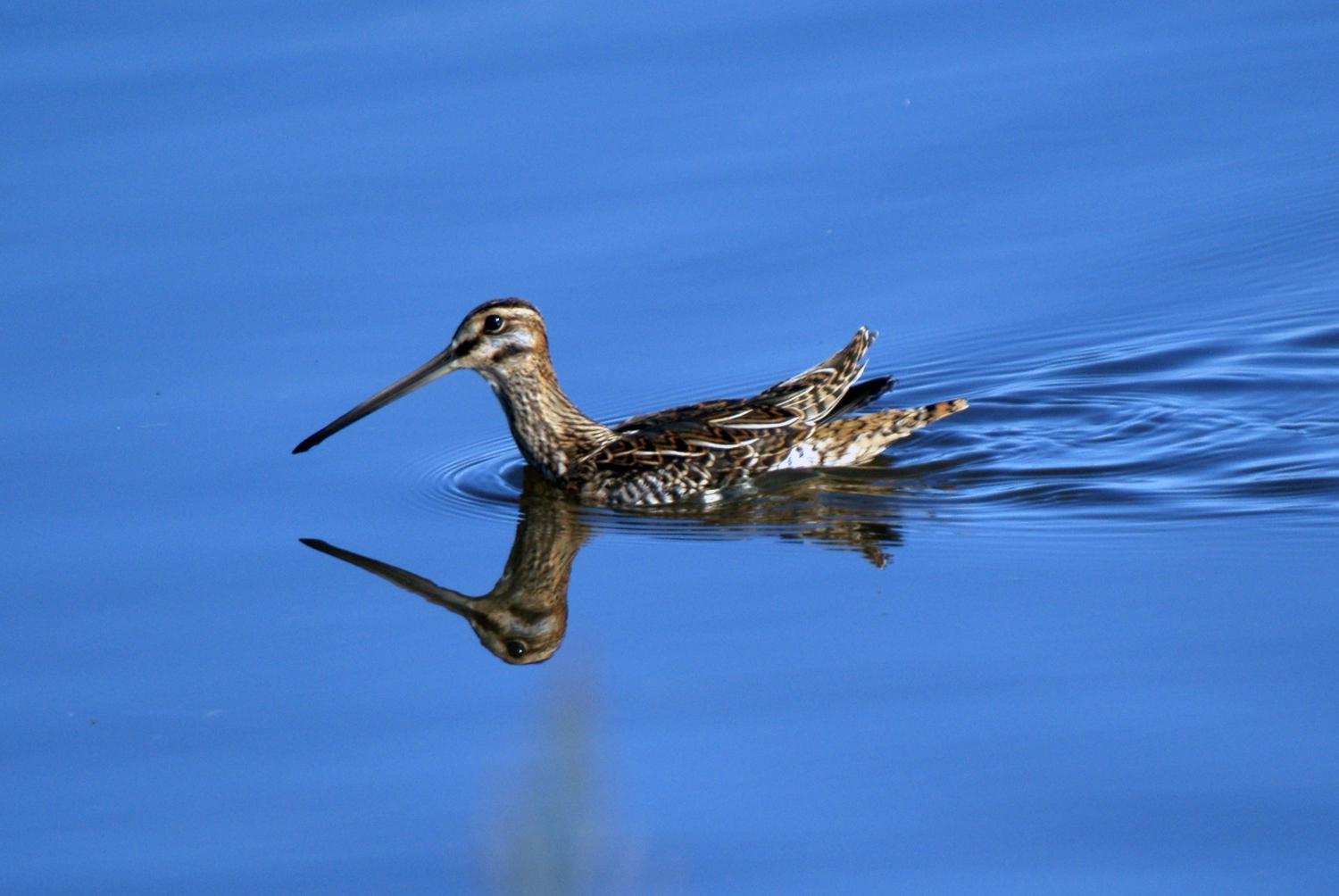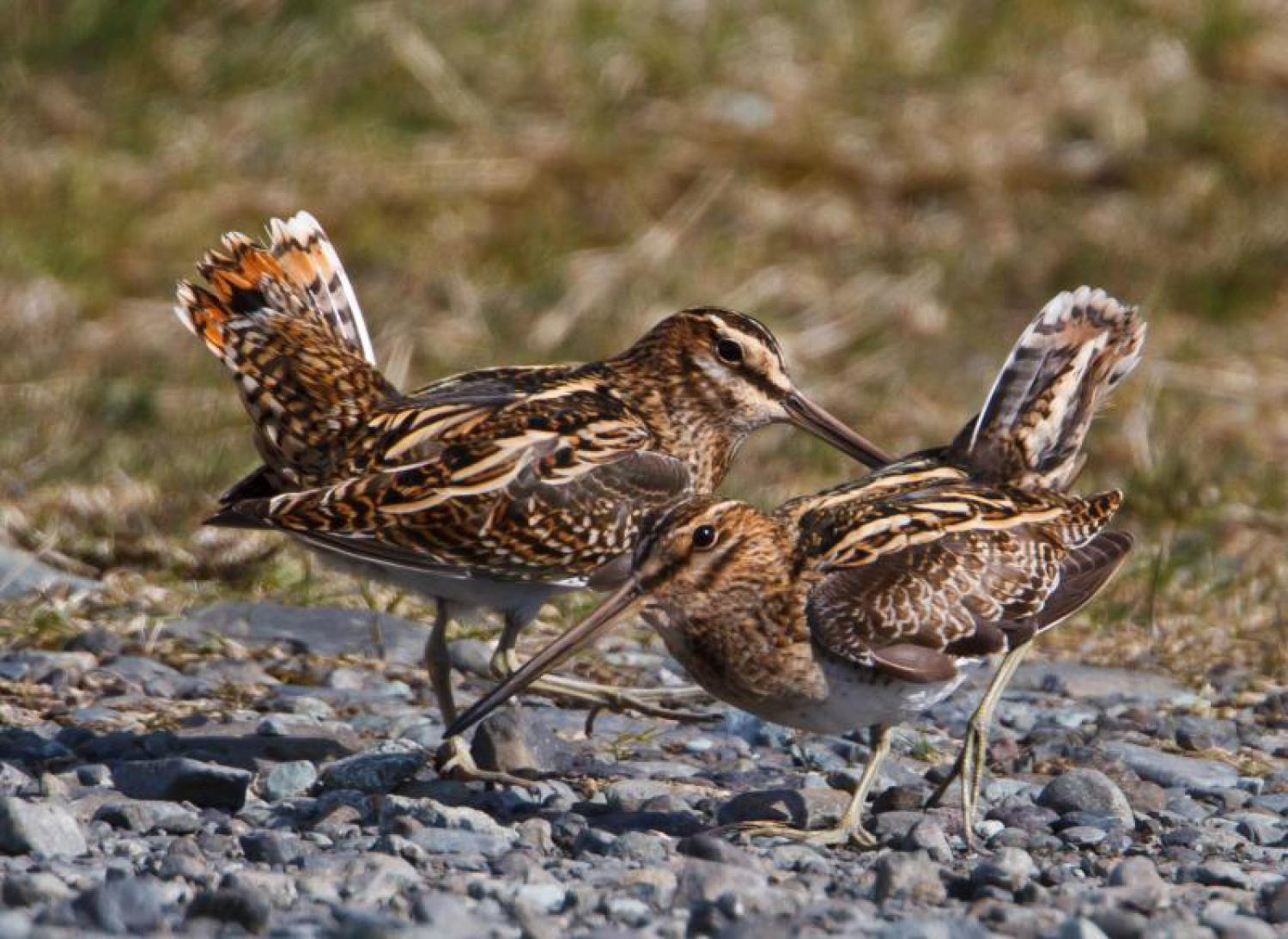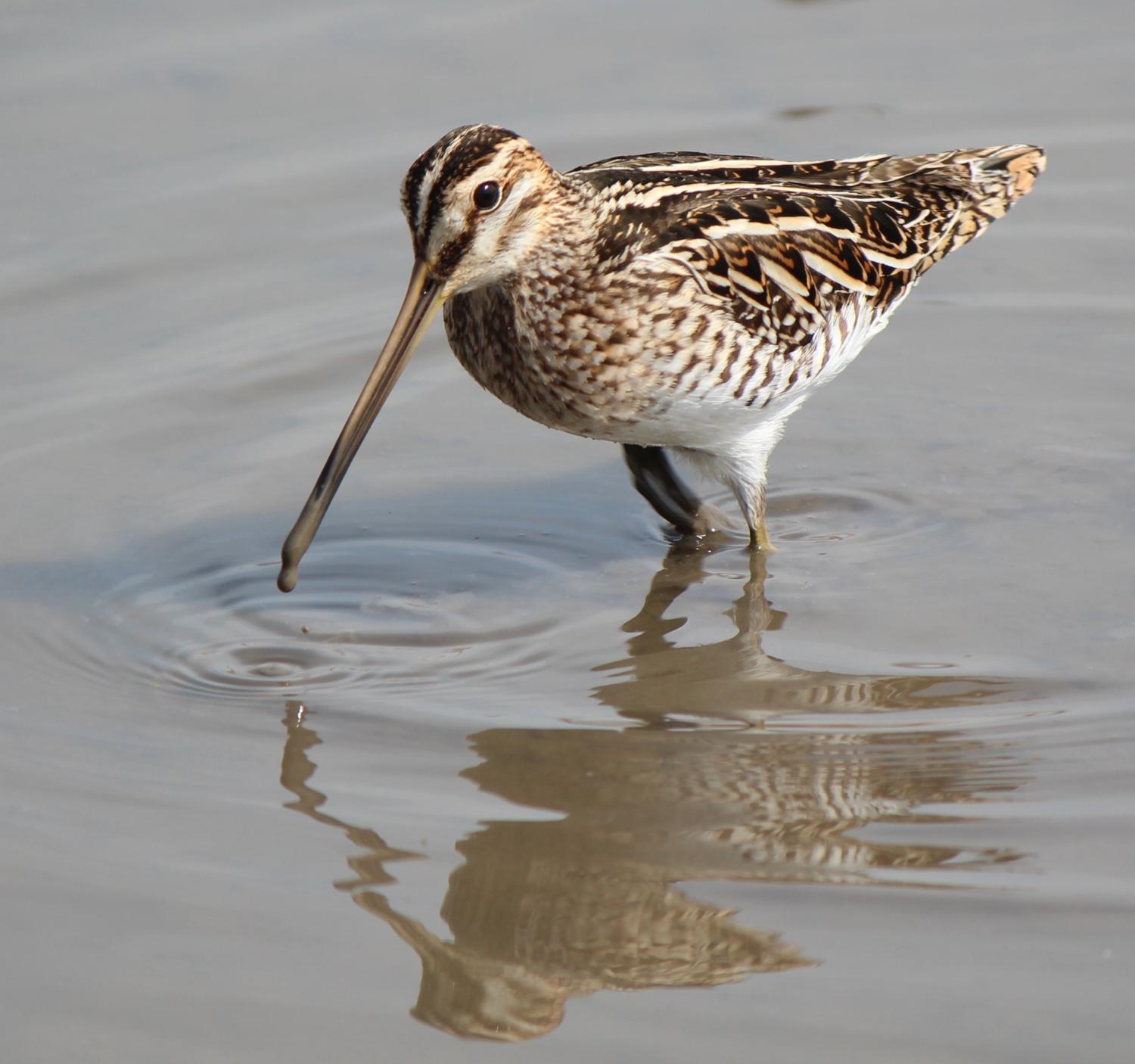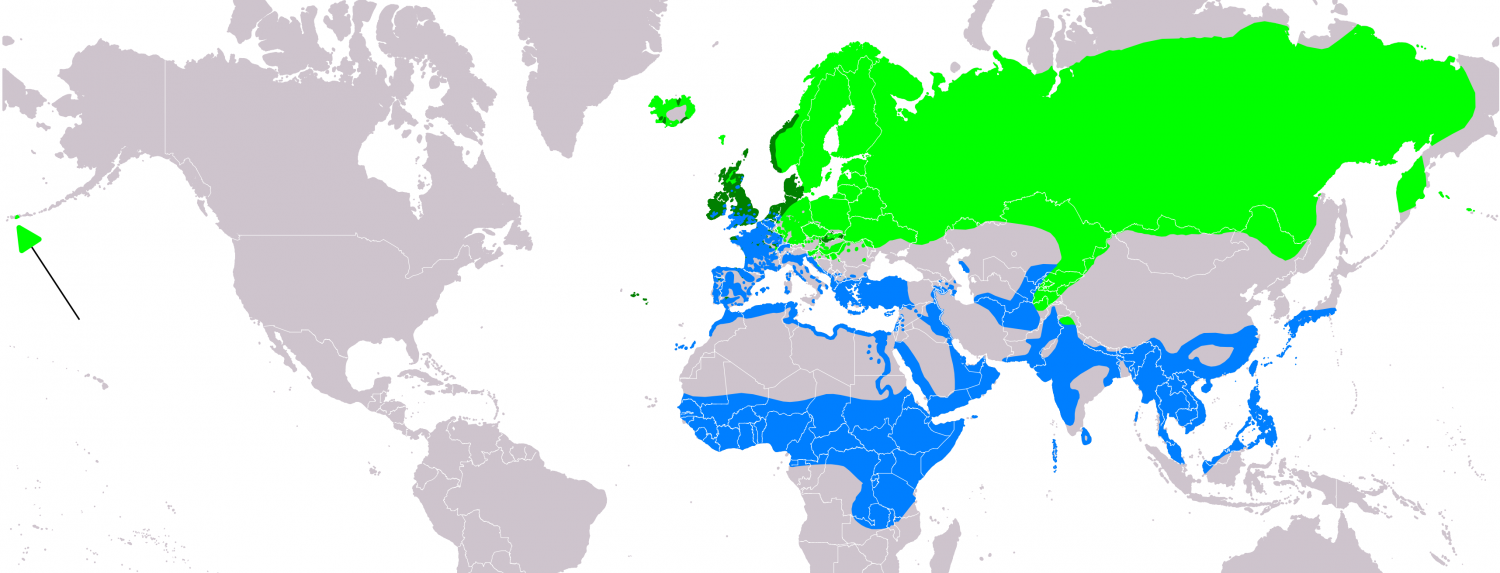Species of Thailand
Common snipe
Gallinago gallinago
Carolus Linnaeus, 1758
In Thai: นกปากซ่อมหางพัด
The common snipe (Gallinago gallinago) is a small, stocky wader native to the Old World. The scientific name gallinago is New Latin for a woodcock or snipe from Latin gallina, "hen" and the suffix -ago, "resembling".
The breeding habitat is marshes, bogs, tundra and wet meadows throughout the Palearctic.In the north, the distribution limit extends from Iceland over the north of the British Isles and northern Fennoscandia , where it occurs at around 70 ° N, as well as through European Russia and Siberia . Here it is mostly on the northern edge of the Taiga zone at 71 ° N, but reaches 74 ° N on the east coast of the Taymyr Peninsula. In the east it extends to the Anadyr, Kamchatka, the Bering Island and the Kuril Islands, The southern boundary of the distribution area in Europe runs through northern Portugal, central France, northern Italy, Bulgaria and the Ukraine, with populations in the west being only very scattered. In Asia, the distribution extends south to northern Turkestan, locally to Afghanistan and the Middle East, through the Altai and further to Manchuria and Ussuri. It is migratory, with European birds wintering in southern and western Europe and Africa (south to the Equator), and Asian migrants moving to tropical southern Asia. The North American Wilson's snipe was previously considered the same species, and is listed as such in older field guides.
Description
Adults are 25 – 27 cm in length with a 44 – 47 cm wingspan and a weight of 80 - 140 g (up to 180 g pre-migration). They have short greenish-grey legs and a very long (5.5 – 7 cm) straight dark bill. The body is mottled brown with straw-yellow stripes on top and pale underneath. They have a dark stripe through the eye, with light stripes above and below it. The wings are pointed.
It is the most widespread of several similar snipes. It most closely resembles the Wilson's snipe (G. delicata) of North America, which was until recently considered to be a subspecies — G. g. delicata — of common snipe. They differ in the number of tail feathers, with seven pairs in G. gallinago and eight pairs in G. delicata; the North American species also has a slightly thinner white trailing edge to the wings (the white is mostly on the tips of the secondaries). Both species breed in the Aleutian Islands. It is also very similar to the pin-tailed snipe (G. stenura) and Swinhoe's snipe (G. megala) of eastern Asia; identification of these species there is complex.
There are two subspecies of common snipe, G. g. faeroeensis in Iceland, the Faroes, Shetland and Orkney (wintering in Britain and Ireland), and G. g. gallinago in the rest of the Old World. The faeroeensis normally is more richly toned on the breast, its upperparts and the head than the gallinago.
Ecology
It is a well camouflaged bird, it is usually shy and conceals itself close to ground vegetation and flushes only when approached closely. When flushed, they utter a sharp note that sounds like scape, scape and fly off in a series of aerial zig-zags to confuse predators. They forage in soft mud, probing or picking up food by sight. They mainly eat insects and earthworms, also some plant material.
The male performs "winnowing" display during courtship, flying high in circles and then taking shallow dives to produce a "drumming" sound by vibrating its tail feathers. This sound has been compared by others to the bleating of a sheep or goat; hence in many languages the snipe is known by names signifying “flying goat, ” “heaven's ram, ” as in Scotland by “heather-bleater” and in Finnish the name taivaanvuohi, "sky goat".
Philip Manson-Bahr is credited with unravelling the mystery of how the snipe creates that unusual breathy sound which is unlike other birdsong. He worked out that the sound was created by placing out two tail feathers at 90 degrees to the direction of flight. When diving these feathers create this unusual sound. He demonstrated this in front of the British Ornithologists Union by inserting two snipe feathers into a cork which he then whirled around his head on a string.
Wing shape does not differ between sedentary and migratory common snipe, suggesting that social selection influences wing shape given this species aerial displays during courtship.
Common snipe nest in a well-hidden location on the ground, laying four eggs of a dark olive colour, blotched and spotted with rich brown, which are incubated by the female for 18–21 days. The freshly hatched young are covered in dark maroon down, variegated with black, white and buff. The young are cared for by both parents, each parent looking after half the brood, with fledging in 10–20 days.
Conservation
Overall, the species is not threatened. Populations on the southern fringes of the breeding range in Europe are however declining with local extinction in some areas (notably in parts of England and Germany), mainly due to field drainage and agricultural intensification.
The Agreement on the Conservation of African-Eurasian Migratory Waterbirds (AEWA) applies to the species. It is still hunted as a gamebird in much of its range.
History
Old folk names include "mire snipe", "horse gowk", "heather bleat", and the variant spelling "snite". See snipe for other aspects of the name.
This article uses material from Wikipedia released under the Creative Commons Attribution-Share-Alike Licence 3.0. Eventual photos shown in this page may or may not be from Wikipedia, please see the license details for photos in photo by-lines.
Category / Seasonal Status
Wiki listed status (concerning Thai population): Winter visitor
BCST Category: Recorded in an apparently wild state within the last 50 years
BCST Seasonal status: Non-breeding visitor
Scientific classification
- Kingdom
- Animalia
- Phylum
- Chordata
- Class
- Aves
- Order
- Charadriiformes
- Family
- Scolopacidae
- Genus
- Gallinago
- Species
- Gallinago gallinago
Common names
- Thai: นกปากซ่อมหางพัด
Synonyms
- Scolopax gallinago, Carolus Linnaeus (1758)
- Capella gallinago, Carolus Linnaeus (1758)
Conservation status

Least Concern (IUCN3.1)
Photos
Please help us review the bird photos if wrong ones are used. We can be reached via our contact us page.
Range Map
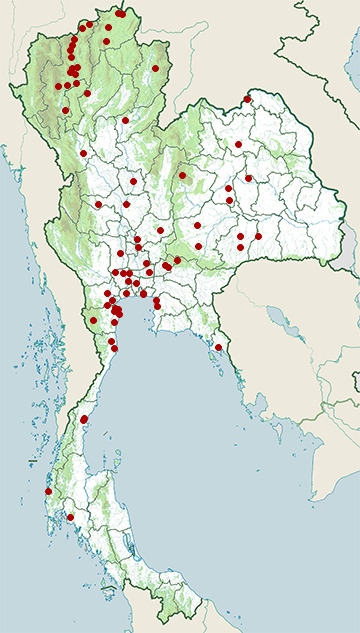
- Amphawa District, Samut Songkhram
- Ban Laem District, Phetchaburi
- Ban Phai District, Khon Kaen
- Ban Phraek District, Phra Nakhon Si Ayutthaya
- Bang Len District, Nakhon Pathom
- Bang Phra Non-Hunting Area
- Bang Pu Recreation Centre
- Bangkok Province
- Bueng Boraped Non-Hunting Area
- Chiang Dao District, Chiang Mai
- Chiang Dao Wildlife Sanctuary
- Chiang Saen District, Chiang Rai
- Chum Ta Bong District, Nakhon Sawan
- Doi Inthanon National Park
- Doi Lo District, Chiang Mai
- Doi Suthep - Pui National Park
- Doi Tao District, Chiang Mai
- Fang District, Chiang Mai
- Hang Chat District, Lampang
- Huai Chorakhe Mak Reservoir Non-Hunting Area
- Kaeng Krachan National Park
- Kamphaeng Saen District, Nakhon Pathom
- Kantharawichai District, Maha Sarakham
- Khao Nang Phanthurat Forest Park
- Khao Sam Roi Yot National Park
- Khao Yai National Park
- Khao Yoi District, Phetchaburi
- Kumphawapi District, Udon Thani
- Laem Pak Bia
- Mae Ai District, Chiang Mai
- Mae Rim District, Chiang Mai
- Mae Taeng District, Chiang Mai
- Mueang Chiang Mai District, Chiang Mai
- Mueang Chiang Rai District, Chiang Rai
- Mueang Chonburi District, Chonburi
- Mueang Chumphon District, Chumphon
- Mueang Krabi District, Krabi
- Mueang Lamphun District, Lamphun
- Mueang Nakhon Nayok District, Nakhon Nayok
- Mueang Phetchaburi District, Phetchaburi
- Mueang Ratchaburi District, Ratchaburi
- Mueang Samut Sakhon District, Samut Sakhon
- Mueang Suphanburi District, Suphan Buri
- Mueang Surin District, Surin
- Mueang Tak District, Tak
- Mueang Trat District, Trat
- Mueang Uttaradit District, Uttaradit
- Non Thai District, Nakhon Ratchasima
- Nong Bong Khai Non-Hunting Area
- Nong Song Hong District, Khon Kaen
- Nong Yai Area Development Project Under Royal Init
- Pa Sak Chonlasit Dam Non-Hunting Area
- Pak Phli District, Nakhon Nayok
- Pak Thale
- Pak Thong Chai District, Nakhon Ratchasima
- Pha Daeng National Park
- Phan District, Chiang Rai
- Phu Khiao Wildlife Sanctuary
- Phutthamonthon District, Nakhon Pathom
- Pran Buri District, Prachuap Khiri Khan
- Rattanawapi District, Nong Khai
- Sai Noi District, Nonthaburi
- Samut Prakan Province
- San Sai District, Chiang Mai
- Sanam Bin Reservoir Non-Hunting Area
- Santi Suk District, Nan
- Takua Pa District, Phang Nga
- Taphan Hin District, Phichit
- Tha Wung District, Lopburi
- Thanyaburi District, Pathum Thani
- Wang Noi District, Phra Nakhon Si Ayutthaya
